#british fantasy awards
Text
Earlier today I got hit with a wave of pretty severe pain (my body does this from time to time) and I climbed into the bed and put a gravity blanket on and took a nap. It was incredibly deep and full of very vivid dreams. In one of the dreams, I was looking at an entire room filled with brightly-wrapped pieces of candy, just examining the quality of the foil.
Anyway I woke up from the nap feeling A Bit Off and came back to the computer intending to try to force myself to get a little work done - hard to do when Body Hurts, also hard to do when one knows that ones job COULD be Brightly Colored Foil Inspector - and then I saw this

Apparently, today, JUST LIKE HOME won a BRITISH FANTASY AWARD for Best Horror Novel!! I am totally floored and so honored!!

Thank you so, so much to everyone who nominated, voted, and clapped when my name was announced. I am deeply touched and honored to have won this award. I promise to try to continue making upsetting works of fiction for as long as you'll all have me.
--gailey
105 notes
·
View notes
Photo

‘The Girl from the Sea’ wins a British Fantasy Award
The awards recognize fantasy and horror lit across a variety of categories.
4 notes
·
View notes
Text

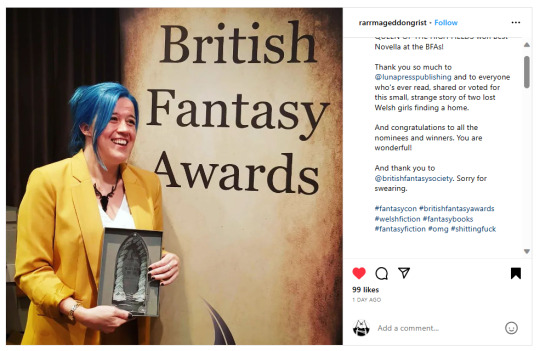
I made this*! (and its 12 siblings)
(*the trophy representing the award, not the cool book that won the award it represents :P)
0 notes
Text
2023 British Fantasy Awards Shortlists
The shortlists for the British Fantasy Awards have been announced.
#fantasy #awards #bfs
The finalists for the 2023 British Fantasy Awards have been announced. Here are the awards and the finalists:
The Robert Holdstock Award for Best Fantasy Novel
Jurors: Elias Eells, Elloise Hopkins, S.D. Howarth, Nadya Mercik, Roseanna Pendlebury
The Bone Orchard – Sara A. Mueller (Tor)
Cast Long Shadows – Cat Hellisen (Luna Press Publishing)
Glitterati – Oliver K. Langmead (Titan)
The…
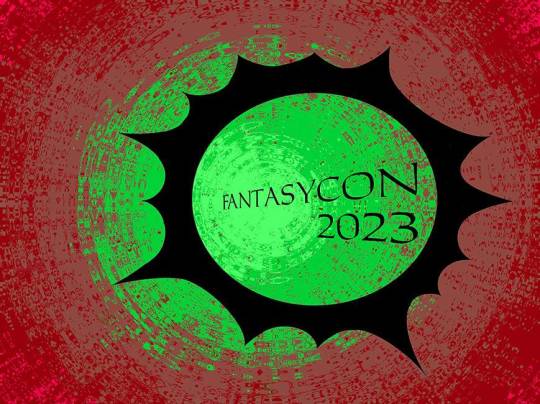
View On WordPress
0 notes
Text
MONSTROUS AGONIES JUST WON THIS YEAR'S BRITISH FANTASY AWARD FOR BEST AUDIO!!!

absolutely blown away, do not know what to do with myself rn lol im just sitting on the stairs (why??? how did i end up here???) staring at my phone, agog 😍🤩😱
311 notes
·
View notes
Text
British Fantasy Awards 2023
This evening I attended the British Fantasy Awards. I’m at FantasyCon 2023 in Birmingham. Allen Stroud compered the Awards.
Continue reading Untitled

View On WordPress
0 notes
Text
Oooh! A great Gavin Finney (Good Omens Director of Photography) interview with Helen Parkinson for the British Cinematographer! :)
HEAVEN SENT
Gifted a vast creative landscape from two of fantasy’s foremost authors to play with, Gavin Finney BSC reveals how he crafted the otherworldly visuals for Good Omens 2.
It started with a letter from beyond the grave. Following fantasy maestro Sir Terry Pratchett’s untimely death in 2015, Neil Gaiman decided he wouldn’t adapt their co-authored 1990 novel, Good Omens, without his collaborator. That was, until he was presented with a posthumous missive from Pratchett asking him to do just that.
For Gaiman, it was a request that proved impossible to decline: he brought Good Omens season one to the screen in 2019, a careful homage to its source material. His writing, complemented by some inspired casting – David Tennant plays the irrepressible demon Crowley, alongside Michael Sheen as angel-slash-bookseller Aziraphale – and award-nominated visuals from Gavin Finney BSC, proved a potent combination for Prime Video viewers.
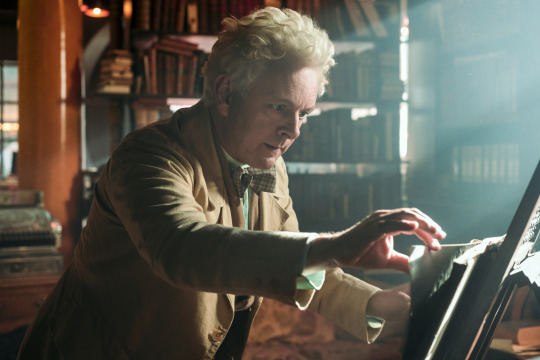
Aziraphale’s bookshop was a set design triumph.
Season two departs from the faithful literary adaptation of its predecessor, instead imagining what comes next for Crowley and Aziraphale. Its storyline is built off a conversation that Pratchett and Gaiman shared during a jetlagged stay in Seattle for the 1989 World Fantasy Convention. Gaiman remembers: “The idea was always that we would tell the story that Terry and I came up with in 1989 in Seattle, but that we would do that in our own time and in our own way. So, once Good Omens (S1) was done, all I knew was that I really, really wanted to tell the rest of the story.”
Telling that story visually may sound daunting, but cinematographer Finney is no stranger to the wonderfully idiosyncratic world of Pratchett and co. As well as lensing Good Omens’ first outing, he’s also shot three other Pratchett stories – TV mini series Hogfather (2006), and TV mini-series The Colour of Magic (2008) and Going Postal (2010).
He relishes how the authors provide a vast creative landscape for him to riff off. “The great thing about Pratchett and Gaiman is that there’s no limit to what you can do creatively – everything is up for grabs,” he muses. “When we did the first Pratchett films and the first Good Omens, you couldn’t start by saying, ‘Okay, what should this look like?’, because nothing looks like Pratchett’s world. So, you’re starting from scratch, with no references, and that starting point can be anything you want it to be.”

Season two saw the introduction of inside-outside sets for key locations including Aziraphale’s bookshop.
From start to finish
The sole DP on the six-episode season, Finney was pleased to team up again with returning director Douglas Mackinnon for the “immensely complicated” shoot, and the pair began eight weeks of prep in summer 2021. A big change was the production shifting the main soho set from Bovington airfield, near London, up to Edinburgh’s Pyramids Studio. Much of the action in Good Omens takes place on the Soho street that’s home to Aziraphale’s bookshop, which was built as an exterior set on the former airfield for season one. Season two, however, saw the introduction of inside-outside sets for key locations including the bookshop, record store and pub, to minimise reliance on green screen.
Finney brought over many elements of his season one lensing, especially Mackinnon’s emphasis on keeping the camera moving, which involved lots of prep and testing. “We had a full-time Scorpio 45’ for the whole shoot (run by key grip Tim Critchell and his team), two Steadicam operators (A camera – Ed Clark and B camera Martin Newstead) all the way through, and in any one day we’d often go from Steadicam, to crane, to dolly and back again,” he says. “The camera is moving all the time, but it’s always driven by the story.”
One key difference for season two, however, was the move to large-format visuals. Finney tested three large-format cameras and the winner was the Alexa LF (assisted by the Mini LF where conditions required), thanks to its look and flexibility.
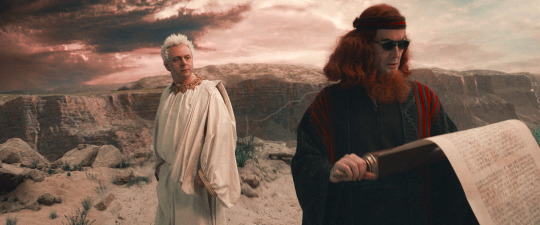
The minisodes were shot on Cooke anamorphics, giving Finney the ideal balance of anamorphic-style glares and characteristics without too much veiling flare.
A more complex decision was finding the right lenses for the job. “You hear about all these whizzy new lenses that are re-barrelled ancient Russian glass, but I needed at least two full sets for the main unit, then another set for the second unit, then maybe another set again for the VFX unit,” Finney explains. “If you only have one set of this exotic glass, it’s no good for the show.”
He tested a vast array of lenses before settling on Zeiss Supremes, supplied by rental house Media Dog. These ticked all the boxes for the project: “They had a really nice look – they’re a modern design but not over sharp, which can look a bit electronic and a bit much, especially with faces. When you’re dealing with a lot of wigs and prosthetics, we didn’t want to go that sharp. The Supremes had a very nice colour palette and nice roll-off. They’re also much smaller than a lot of large-format glass, so that made it easy for Steadicam and remote cranes. They also provided additional metadata, which was very useful for the VFX department (VFX services were provided by Milk VFX).”
The Supremes were paired with a selection of filters to characterise the show’s varied locations and characters. For example, Tiffen Bronze Glimmerglass were paired with bookshop scenes; Black Pro-Mist was used for Hell; and Black Diffusion FX for Crowley’s present-day storyline.

Finney worked closely with the show’s DIT, Donald MacSween, and colourist, Gareth Spensley, to develop the look for the minisode.
Maximising minisodes
Episodes two, three and four of season two each contain a ‘minisode’ – an extended flashback set in Biblical times, 1820s Edinburgh and wartime London respectively. “Douglas wanted the minisodes to have very strong identities and look as different from the present day as possible, so we’d instantly know we were in a minisode and not the present day,” Finney explains.
One way to shape their distinctive look was through using Cooke anamorphic lenses. As Finney notes: “The Cookes had the right balance of controllable, anamorphic-style flares and characteristics without having so much veiling flare that they would be hard to use on green screens. They just struck the right balance of aesthetics, VFX requirements and availability.” The show adopted the anamorphic aspect ratio (2:39.1), an unusual move for a comedy, but one which offered them more interesting framing opportunities.
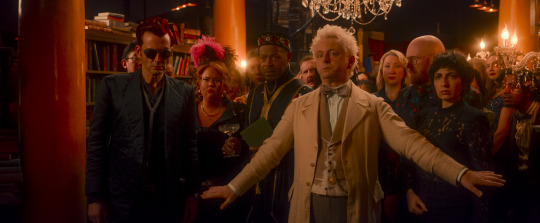
Good Omens 2 was shot on the Alexa LF, paired with Zeiss Supremes for the present-day scenes.
The minisodes were also given various levels of film grain to set them apart from the present-day scenes. Finney first experimented with this with the show’s DIT Donald MacSween using the DaVinci Resolve plugin FilmConvert. Taking that as a starting point, the show’s colourist, Company 3’s Gareth Spensley, then crafted his own film emulation inspired by two-strip Technicolor. “There was a lot of testing in the grade to find the look for these minisodes, with different amounts of grain and different types of either Technicolor three-strip or two-strip,” Finney recalls. “Then we’d add grain and film weave on that, then on top we added film flares. In the Biblical scenes we added more dust and motes in the air.”
Establishing the show’s lighting was a key part of Finney’s testing process, working closely with gaffer Scott Napier and drawing upon PKE Lighting’s inventory. Good Omens’ new Scottish location posed an initial challenge: as the studio was in an old warehouse rather than being purpose-built for filming, its ceilings weren’t as high as one would normally expect. This meant Finney and Napier had to work out a low-profile way of putting in a lot of fixtures.
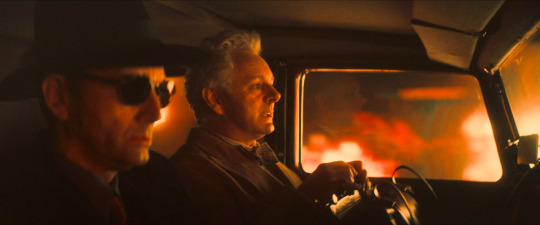
Inside Crowley’s treasured Bentley.
Their first task was to test various textiles, LED wash lights and different weight loadings, to establish what they were working with for the street exteriors. “We worked out that what was needed were 12 SkyPanels per 20’x20’ silk, so each one was a block of 20’x20’, then we scaled that up,” Finney recalls. “I wanted a very seamless sky, so I used full grid cloth which made it very, very smooth. That was important because we’ve got lots of cars constantly driving around the set and the sloped windscreens reflect the ceiling. So we had to have seamless textiles – PKE had to source around 12,000 feet of textiles so that we could put them together, so the reflections in the windscreens of the cars just showed white gridcloth rather than lots of stage lights. We then drove the car around the set to test it from different angles.”
On the floor, they mostly worked with LEDs, providing huge energy and cost savings for the production. Astera’s Titan Tubes came in handy for a fun flashback scene with John Hamm’s character Gabriel. The DP remembers: “[Gabriel] was travelling down a 30-foot feather tunnel. We built a feather tunnel on the stage and wrapped it in a ring of Astera tubes, which were then programmed by dimmer op Jon Towler to animate, pulse and change different colours. Each part of Gabriel’s journey through his consciousness has a different colour to it.”
Among the rigs built was a 20-strong Creamsource Vortex setup for the graveyard scene in the “Body Snatchers” minisode, shot in Stirling. “We took all the yokes off each light then put them on a custom-made aluminium rig so we could have them very close. We put them up on a big telehandler on a hill that gave me a soft mood light, which was very adjustable, windproof and rainproof.”

Shooting on the VP stage for the birth of the universe scenes in episode one.
Sky’s the limit
A lot of weather effects were done in camera – including lightning effects pulsed in that allowed both direct fork lightning and sheet lightning to spread down the streets. In the grade, colourist Spensley was also able to work his creative magic on the show’s skies. “Gareth is a very artistic colourist – he’s a genius at changing skies,” Finney says. “Often in the UK you get these very boring, flat skies, but he’s got a library of dramatic skies that you can drop in. That would usually be done by VFX, but he’s got the ability to do it in Baselight, so a flat sky suddenly becomes a glorious sunset.”
Finney emphasises that the grade is a very involved process for a series like Good Omens, especially with its VFX-heavy nature. “This means VFX sequences often need extra work when it comes back into the timeline,” says the DP. “So, we often add camera movement or camera shake to crank the image up a bit. Having a colourist like Gareth is central to a big show like Good Omens, to bring all the different visual elements together and to make it seamless. It’s quite a long grade process but it’s worth its weight in gold.”


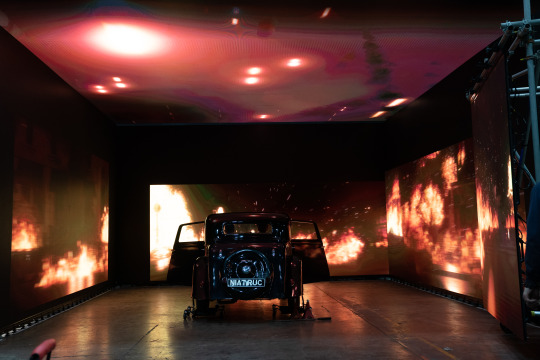
Shooting in the VR cube for the blitz scenes .
Finney took advantage of virtual production (VP) technology for the driving scenes in Crowley’s classic Bentley. The volume was built on their Scottish set: a 4x7m cube with a roof that could go up and down on motorised winches as needed. “We pulled the cars in and out on skates – they went up on little jacks, which you could then rotate and move the car around within the volume,” he explains. “We had two floating screens that we could move around to fill in and use as additional source lighting. Then we had generated plates – either CGI or real location plates –projected 360º around the car. Sometimes we used the volume in-camera but if we needed to do more work downstream; we’d use a green screen frustum.” Universal Pixels collaborated with Finney to supply in-camera VFX expertise, crew and technical equipment for the in-vehicle driving sequences and rear projection for the crucial car shots.

John Hamm was suspended in the middle of this lighting rig and superimposed into the feather tunnel.
Interestingly, while shooting at a VP stage in Leith, the team also used the volume as a huge, animated light source in its own right – a new technique for Finney. “We had the camera pointing away from [the volume] so the screen provided this massive, IMAX-sized light effect for the actors. We had a simple animation of the expanding universe projected onto the screen so the actors could actually see it, and it gave me the animated light back on the actors.”
Bringing such esteemed authors’ imaginations to the screen is no small task, but Finney was proud to helped bring Crowley and Aziraphale’s adventures to life once again. He adds: “What’s nice about Good Omens, especially when there’s so much bad news in the world, is that it’s a good news show. It’s a very funny show. It’s also about good and evil, love and doing the right thing, people getting together irrespective of backgrounds. It’s a hopeful message, and I think that that’s what we all need.”
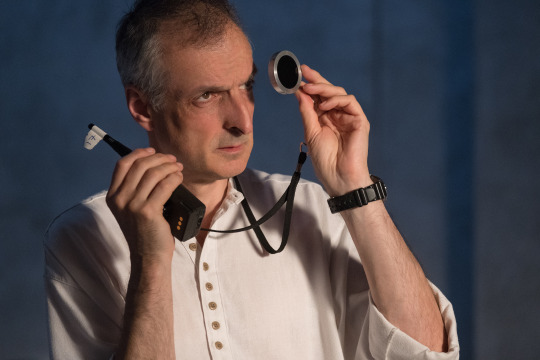
Finney is no stranger to the idiosyncratic world of Sir Terry Pratchett and Neil Gaiman.
#good omens#gos2#season 2#interview#gavin finney#neil gaiman#terry pratchett#gavin finney interview interview#s2 interview#bts#fun fact#british cinematographer#british cinematographer 2023#jon hamm#2ep1#2ep2#2ep3#2ep4#2ep6#2i1i1#job's minisode#1941 minisode#1827 minisode#2i6i7#bentley
2K notes
·
View notes
Text
2022 Shortlist for Waterstones Book of the Year
2022 Shortlist for Waterstones Book of the Year
Waterstones, the UK Bookseller, released their yearly shortlist of this year’s best books of the year. The shortlist and award is selected by booksellers.
If you are not looking to add more books to add to your TBR shelf, then reading this shortlist is highly unadvisable, you ‘ll have a hard time tearing your eyes away from these interesting blurbs:
(more…)

View On WordPress
#Alice Oseman#Bonnie Garmus#Book Prizes#Books#British Literature#British Museum#British mysteries#British nonfiction#Children#Fantasy#Fantasy Books#Heartstopper#History#Irish Authors#Irish Literature#Literary Awards#Literary Prizes#Nonfiction#UK Books#UK Children Books#UK YA Books#Waterstones#Waterstones Book of the Year
0 notes
Text
How the heck is there not more talk about Tanith Lee??
Like my gosh, the woman wrote, according to her wiki, 90 books, over 300 short stories, two World Fantasy Awards, and was the first woman to win the British Fantasy Award/Augus Derleth Award and wrote for tv shows.
Like, it's not like she just wrote a heck ton but wasn't very good! She was clearly very good she won awards, and i've read a swath of her stuff across different genres and really enjoyed most of it. I mean that even if not each one has been my cup of tea I can at least appreciate the skill and quite a lot I have truly enjoyed. She's got great prose and style and imagination. Not everything obviously was a banger, but they've all been at least well written, which is harder to come by in writing than you might think.
But nobody ever seems to talk about her?? And I feel like the fantasy crowd on here would really enjoy her stuff. The woman has done stuff in pretty much every genre from what I can see, but I never see her listed on fantasy authors like Clive Barker or Diana Wynne Jones or Neil Gaiman or Terry Pratchett or Diane Duane even though she was writing at the same time and has a similar sort of '80s Doing Cool Stuff with Fantasy vibe' I feel like people who like those authors would enjoy though she's very much her own style of author.
Anyway this was really just me putting out a rant that such a prolific and talented author seems to have fallen by the wayside and I think it's really a shame
Heck she even did a witch-queen fighting againt vampire Snow White a whole decade before Neil Gaiman did his phenomenal Snow Glass Apples and it's also excellent, give a look here:
youtube
#tanith lee#fantasy authors#fantasy books#70s fantasy#80s fantasy#90s fantasy#british fantasy#British writers#i dunno how to tag i just want this woman to be remembered darn it#Youtube#i hope its ok to tag the authors mentioned#not trying to spam but like also want the fan crossover to get people interested in her again?#i dont know why i'm taking this so personally xD#neil gaiman#diane duane#terry pratchett#clive barker#diana wynne jones#vampire snow white
2K notes
·
View notes
Text
So for those unaware of what just went down, a whistleblower has exposed that last year the American / Canadian / and UK comity of the Hugo Awards deliberately removed some nominations specifically because those nominations might offend the Chinese government.
The Hugo Awards (until now) were a very respected scifi / fantasy award. In years past Neil Gaiman had won Hugo awards for such things as The Sandman: Overture and other works.
However the nominations removed last year to avoid offending China included episode 6 of the Netflix adaptation of Neil Gaiman's The Sandman, likely because it showed Death taking souls to the afterlife. The Chinese government does not like Western depictions of the afterlife.
This has blown up into a very big and interesting scandal and now Neil Gaiman and The Sandman Netflix series are part of it.
I grew tired of Hollywood pandering to China years ago when I found out that's why so many horror reboots removed supernatural elements (i.e. the Child's Play remake turning Chucky into an evil AI robot doll instead of a possessed talking doll).
The Chinese market does not like western depictions of ghosts or the afterlife and this has lead to a steep decrease in high budget supernatural horror and why most horror is now made by smaller, low-budget divisions like Blumhouse.
Disney couldn't even put a Haunted Mansion in Hong Kong Disney. Instead it's "Mystic Manor" which isn't haunted at all but just "enchanted" with "living furniture." The popular excuse they give is that the Chinese culture has different views on ghosts than us. Bull. I've read plenty of scary Chinese ghost stories. And they don't mind western depictions of ghosts if they happen to be in Korean or Japanese animation.
152 notes
·
View notes
Text
NYT's Notable Books of 2023
Each year, we pore over thousands of new books, seeking out the best novels, memoirs, biographies, poetry collections, stories and more. Here are the standouts, selected by the staff of The New York Times Book Review.
AFTER SAPPHO by Selby Wynn Schwartz
Inspired by Sappho’s work, Schwartz’s debut novel offers an alternate history of creativity at the turn of the 20th century, one that centers queer women artists, writers and intellectuals who refused to accept society’s boundaries.
ALL THE SINNERS BLEED by S.A. Cosby
In his earlier thrillers, Cosby worked the outlaw side of the crime genre. In his new one — about a Black sheriff in a rural Southern town, searching for a serial killer who tortures Black children — he’s written a crackling good police procedural.
THE BEE STING by Paul Murray
In Murray’s boisterous tragicomic novel, a once wealthy Irish family struggles with both the aftermath of the 2008 financial crash and their own inner demons.
BIOGRAPHY OF X by Catherine Lacey
Lacey rewrites 20th-century U.S. history through the audacious fictional life story of X, a polarizing female performance artist who made her way from the South to New York City’s downtown art scene.
BIRNAM WOOD by Eleanor Catton
In this action-packed novel from a Booker Prize winner, a collective of activist gardeners crosses paths with a billionaire doomsday prepper on land they each want for different purposes.
BLACKOUTS by Justin Torres
This lyrical, genre-defying novel — winner of the 2023 National Book Award — explores what it means to be erased and how to persist after being wiped away.
BRIGHT YOUNG WOMEN by Jessica Knoll
In her third and most assured novel, Knoll shifts readers’ attention away from a notorious serial killer, Ted Bundy, and onto the lives — and deaths — of the women he killed. Perhaps for the first time in fiction, Knoll pooh-poohs Bundy's much ballyhooed intelligence, celebrating the promise and perspicacity of his victims instead.
CHAIN-GANG ALL-STARS by Nana Kwame Adjei-Brenyah
This satire — in which prison inmates duel on TV for a chance at freedom — makes readers complicit with the bloodthirsty fans sitting ringside. The fight scenes are so well written they demonstrate how easy it might be to accept a world this sick.
THE COVENANT OF WATER by Abraham Verghese
Verghese’s first novel since “Cutting for Stone” follows generations of a family across 77 years in southwestern India as they contend with political strife and other troubles — capped by a shocking discovery made by the matriarch’s granddaughter, a doctor.
CROOK MANIFESTO by Colson Whitehead
Returning to the world of his novel “Harlem Shuffle,” Whitehead again uses a crime story to illuminate a singular neighborhood at a tipping point — here, Harlem in the 1970s.
THE DELUGE by Stephen Markley
Markley’s second novel confronts the scale and gravity of climate change, tracking a cadre of scientists and activists from the gathering storm of the Obama years to the super-typhoons of future decades. Immersive and ambitious, the book shows the range of its author’s gifts: polyphonic narration, silken sentences and elaborate world-building.
EASTBOUND by Maylis de Kerangal
In de Kerangal’s brief, lyrical novel, translated by Jessica Moore, a young Russian soldier on a trans-Siberian train decides to desert and turns to a civilian passenger, a Frenchwoman, for help.
EMILY WILDE’S ENCYCLOPAEDIA OF FAERIES by Heather Fawcett
The world-building in this tale of a woman documenting a new kind of faerie is exquisite, and the characters are just as textured and richly drawn. This is the kind of folkloric fantasy that remembers the old, blood-ribboned source material about sacrifices and stolen children, but adds a modern gloss.
ENTER GHOST by Isabella Hammad
In Hammad’s second novel, a British Palestinian actor returns to her hometown in Israel to recover from a breakup and spend time with her family. Instead, she’s talked into joining a staging of “Hamlet” in the West Bank, where she has a political awakening.
FORBIDDEN NOTEBOOK by Alba de Céspedes
A best-selling novelist and prominent anti-Fascist in her native Italy, de Céspedes has lately fallen into unjust obscurity. Translated by Ann Goldstein, this elegant novel from the 1950s tells the story of a married mother, Valeria, whose life is transformed when she begins keeping a secret diary.
THE FRAUD by Zadie Smith
Based on a celebrated 19th-century trial in which the defendant was accused of impersonating a nobleman, Smith’s novel offers a vast panoply of London and the English countryside, and successfully locates the social controversies of an era in a handful of characters.
FROM FROM by Monica Youn
In her fourth book of verse, a svelte, intrepid foray into American racism, Youn turns a knowing eye on society’s love-hate relationship with what it sees as the “other.”
A GUEST IN THE HOUSE by Emily Carroll
After a lonely young woman marries a mild-mannered widower and moves into his home, she begins to wonder how his first wife actually died. This graphic novel alternates between black-and-white and overwhelming colors as it explores the mundane and the horrific.
THE HEAVEN & EARTH GROCERY STORE by James McBride
McBride’s latest, an intimate, big-hearted tale of community, opens with a human skeleton found in a well in the 1970s, and then flashes back to the past, to the ’20s and ’30s, to explore the town’s Black, Jewish and immigrant history.
HELLO BEAUTIFUL by Ann Napolitano
In her radiant fourth novel, Napolitano puts a fresh spin on the classic tale of four sisters and the man who joins their family. Take “Little Women,” move it to modern-day Chicago, add more intrigue, lots of basketball and a different kind of boy next door and you’ve got the bones of this thoroughly original story.
A HISTORY OF BURNING by Janika Oza
This remarkable debut novel tells the story of an extended Indo-Ugandan family that is displaced, settled and displaced again.
HOLLY by Stephen King
The scrappy private detective Holly Gibney (who appeared in “The Outsider” and several other novels) returns, this time taking on a missing-persons case that — in typical King fashion — unfolds into a tale of Dickensian proportions.
A HOUSE FOR ALICE by Diana Evans
This polyphonic novel traces one family’s reckoning after the patriarch dies in a fire, as his widow, a Nigerian immigrant, considers returning to her home country and the entire family re-examines the circumstances of their lives.
THE ILIAD by Homer
Emily Wilson’s propulsive new translation of the “Iliad” is buoyant and expressive; she wants this version to be read aloud, and it would certainly be fun to perform.
INK BLOOD SISTER SCRIBE by Emma Törzs
The sisters in Törzs's delightful debut have been raised to protect a collection of magic books that allow their keepers to do incredible things. Their story accelerates like a fugue, ably conducted to a tender conclusion.
KAIROS by Jenny Erpenbeck
This tale of a torrid, yearslong relationship between a young woman and a much older married man — translated from the German by Michael Hofmann — is both profound and moving.
KANTIKA by Elizabeth Graver
Inspired by the life of Graver’s maternal grandmother, this exquisitely imagined family saga spans cultures and continents as it traces the migrations of a Sephardic Jewish girl from turn-of-the-20th-century Constantinople to Barcelona, Havana and, finally, Queens, N.Y.
LAND OF MILK AND HONEY by C Pam Zhang
Zhang’s lush, keenly intelligent novel follows a chef who’s hired to cook for an “elite research community” in the Italian Alps, in a not-so-distant future where industrial-agricultural experiments in America’s heartland have blanketed the globe in a crop-smothering smog.
LONE WOMEN by Victor LaValle
The year is 1915, and the narrator of LaValle’s horror-tinged western has arrived in Montana to cultivate an unforgiving homestead. She’s looking for a fresh start as a single Black woman in a sparsely populated state, but the locked trunk she has in stow holds a terrifying secret.
MONICA by Daniel Clowes
In Clowes’s luminous new work, the titular character, abandoned by her mother as a child, endures a life of calamities before resolving to learn about her origins and track down her parents.
THE MOST SECRET MEMORY OF MEN by Mohamed Mbougar Sarr
Based on a true story and translated by Lara Vergnaud, Sarr’s novel — about a Senegalese writer brought low by a plagiarism scandal — asks sharp questions about the state of African literature in the West.
THE NEW NATURALS by Gabriel Bump
In Bump’s engrossing new novel, a young Black couple, mourning the loss of their newborn daughter and disillusioned with the world, start a utopian society — but tensions both internal and external soon threaten their dreams.
NORTH WOODS by Daniel Mason
Mason’s novel looks at the occupants of a single house in Massachusetts over several centuries, from colonial times to present day. An apple farmer, an abolitionist, a wealthy manufacturer: The book follows these lives and many others, with detours into natural history and crime reportage.
NOT EVEN THE DEAD by Juan Gómez Bárcena
An ex-conquistador in Spanish-ruled, 16th-century Mexico is asked to hunt down an Indigenous prophet in this novel by a leading writer in Spain, splendidly translated by Katie Whittemore. The epic search stretches across much of the continent and, as the author bends time and history, lasts centuries.
THE NURSERY by Szilvia Molnar
“I used to be a translator and now I am a milk bar.” So begins Molnar’s brilliant novel about a new mother falling apart within the four walls of her apartment.
OUR SHARE OF NIGHT by Mariana Enriquez
This dazzling, epic narrative, translated from the Spanish by Megan McDowell, is a bewitching brew of mystery and myth, peopled by mediums who can summon “the Darkness” for a secret society of wealthy occultists seeking to preserve consciousness after death.
PINEAPPLE STREET by Jenny Jackson
Jackson’s smart, dishy debut novel embeds readers in an upper-crust Brooklyn Heights family — its real estate, its secrets, its just-like-you-and-me problems. Does money buy happiness? “Pineapple Street” asks a better question: Does it buy honesty?
THE REFORMATORY by Tananarive Due
Due’s latest — about a Black boy, Robert, who is wrongfully sentenced to a fictionalized version of Florida’s infamous and brutal Dozier School — is both an incisive examination of the lingering traumas of racism and a gripping, ghost-filled horror novel. “The novel’s extended, layered denouement is so heart-smashingly good, it made me late for work,” Randy Boyagoda wrote in his review. “I couldn’t stop reading.”
THE SAINT OF BRIGHT DOORS by Vajra Chandrasekera
Trained to kill by his mother and able to see demons, the protagonist of Chandrasekera’s stunning and lyrical novel flees his destiny as an assassin and winds up in a politically volatile metropolis.
SAME BED DIFFERENT DREAMS by Ed Park
Double agents, sinister corporations, slasher films, U.F.O.s — Park’s long-awaited second novel is packed to the gills with creative elements that enliven his acerbic, comedic and lyrical odyssey into Korean history and American paranoia.
TAKE WHAT YOU NEED by Idra Novey
This elegant novel resonates with implication beyond the taut contours of its central story line. In Novey’s deft hands, the complex relationship between a young woman and her former stepmother hints at the manifold divisions within America itself.
THIS OTHER EDEN by Paul Harding
In his latest novel, inspired by the true story of a devastating 1912 eviction in Maine that displaced an entire mixed-race fishing community, Harding turns that history into a lyrical tale about the fictional Apple Island on the cusp of destruction.
TOM LAKE by Ann Patchett
Locked down on the family’s northern Michigan cherry orchard, three sisters and their mother, a former actress whose long-ago summer fling went on to become a movie star, reflect on love and regret in Patchett’s quiet and reassuring Chekhovian novel.
THE UNSETTLED by Ayana Mathis
This novel follows three generations across time and place: a young mother trying to create a home for herself and her son in 1980s Philadelphia, and her mother, who is trying to save their Alabama hometown from white supremacists seeking to displace her from her land.
VICTORY CITY by Salman Rushdie
Rushdie’s new novel recounts the long life of Pampa Kampana, who creates an empire from magic seeds in 14th-century India. Her world is one of peace, where men and women are equal and all faiths welcome, but the story Rushdie tells is of a state that forever fails to live up to its ideals.
WE COULD BE SO GOOD by Cat Sebastian
This queer midcentury romance — about reporters who meet at work, become friends, move in together and fall in love — lingers on small, everyday acts like bringing home flowers with the groceries, things that loom large because they’re how we connect with others.
WESTERN LANE by Chetna Maroo
In this polished and disciplined debut novel, an 11-year-old Jain girl in London who has just lost her mother turns her attention to the game of squash — which in Maroo’s graceful telling becomes a way into the girl’s grief.
WITNESS by Jamel Brinkley
Set in Brooklyn, and featuring animal rescue workers, florists, volunteers, ghosts and UPS workers, Brinkley’s new collection meditates on what it means to see and be seen.
Y/N by Esther Yi
In this weird and wondrous novel, a bored young woman in thrall to a boy band buys a one-way ticket to Seoul.
YELLOWFACE by R.F. Kuang
Kuang’s first foray outside of the fantasy genre is a breezy and propulsive tale about a white woman who achieves tremendous literary success by stealing a manuscript from a recently deceased Asian friend and passing it off as her own.
236 notes
·
View notes
Text
Black Women writing SFF
The post about Octavia Butler also made me think about the injustice we do both Butler, SFF readers, and Black women SFF writers by holding her up as the one Black Woman Writing Sci-Fi. She occupies an important place in the genre, for her creativity, the beauty and impact of her writing, and her prolific work... but she's still just one writer, and no one writer works for everybody.
So whether you liked Octavia Butler's books or didn't, here are some of the (many!!! this list is just the authors I've read and liked, or been recommended and been wanting to read) other Black women writing speculative fiction aimed at adults, who might be writing something within your interest:
N. K. Jemisin - a prolific powerhouse of modern sff. Will probably have something you'll like. Won three Hugo awards in a row for her Broken Earth trilogy. I’ve only read her book of short stories, How Long ‘Til Black Future Month? and it is absolutely story after story of bangers. Creative, chilling, beautifully written, make you think. They’re so good and I highly recommend the collection. Several of her novels have spun out of premises she first explored through these short stories, most recently “The City Born Great” giving rise to her novel The City We Became. Leans more fantasy than sci-fi, but has a lot of both, in various permutations.
Nisi Shawl - EDIT: I have been informed that Nisi Shawl identifies as genderfluid, not as a woman. They primarily write short stories that lean literary. Their one novel that I’ve read, Everfair, is an alternate-history 19th century that asks, what if the Congo had fought off European colonization and became a free and independent African state? Told in vignettes spanning decades of political organization, political movements, war tactics, and social development, among an ensemble of local African people, Black Americans coming to the new country, white and mixed-race Brits, and Chinese immigrants who came as British laborers.
Nnedi Okorafor - American-Nigerian writer of Africanfuturism, sci-fi stories emphasizing life in present, future, and alternate-magical Africa. She has range! From Binti, a trilogy of novellas about a teenage girl in Namibia encountering aliens and balancing her newfound connection to space with expectations of her family; to Akata Witch, a middle-grade series about a Nigerian-American girl moving to Nigeria and learning to use magic powers she didn’t know she had; to Who Fears Death, a brutal depiction of magical-realism in a futuristic, post-war Sudan; to short stories like "Africanfuturism 419", about that poor Nigerian prince who’s desperately sending out those emails looking for help (but with a sci-fi twist), and "Mother of Invention" about a smart house taking care of its human and her baby… she’s done a little bit of everything, but always emphasizes the future, the science, and the magic of (usually western) Africa.
Karen Lord - an Afro-Caribbean author. I actually didn’t particularly like the one novel by her I’ve read, The Best of All Possible Worlds, but Martha Wells did, so. Lord has more novels set in this world—a Star Trek-esque multicultural, multispecies spacefuture set on a planet that has welcomed immigrants and refugees for a long time, and become a vibrant multicultural planet. I find her stories rooted in near-future Caribbean socio-climatic concerns like "Haven" and "Cities of the Sun" and her folktale-fantasy style Redemption in Indigo more compelling. And more short stories here.
Bethany C. Morrow - only has one novella (short novel?) for adults, Mem, but it was creative and fascinating and good and I’d be remiss not to shout it out. In an alternate-history 1920s Toronto, scientists have discovered how to extract specific memories from a person—but then those memories are embodied as physical, cloned manifestations of the person at the moment the memory was made. The main character is one such “Mem,” struggling to determine who she is if she was created from and defined by one single traumatic memory that her original-self wanted to remove. It’s mostly quiet, contemplative, and very interesting. (Morrow has some YA novels too. I read one of them and thought it was okay.)
Rebecca Roanhorse - Afro-Indigenous, Black and "Spanish Indian" and married into Diné (Navajo). I’ve read her ongoing post-apocalyptic fantasy series starting with Trail of Lightning, and am liking it a lot; after a climate catastrophe, the spirits and magic of the Diné awakened to protect Dinetah (the Navajo Nation) from the onslaught; and now magic and monsters are part of life in this fundamentally changed world. Coyote is there and he is only sometimes helpful. She also has a more traditional second-world epic high fantasy, Black Sun, an elaborate fantasy world with quests and prophecies and seafaring adventure that draws inspiration from Indigenous cultures of the US and Mexico rather than Europe. She also has bitingly satirical and very incisive short stories like “Welcome to Your Authentic Indian Experience” about virtual reality and cultural tourism, and the fantasy-horror "Harvest."
Micaiah Johnson - her multiverse-hopping novel The Space Between Worlds plays with alternate universes and alternate selves in a continuously creative and interesting way! The setup doesn’t take the easy premise that one universe is our own recognizable one that opens up onto strange alternate universes—even the main character’s home universe is wildly different in speculative ways, with the MC coming from a Mad Max-esque desert community abandoned to the elements, while working for the universe-travel company within the climate-controlled walled city where the rich and well-connected live and work. Also, it’s unabashedly gay.
And if you like audiobooks and audio fiction (I listened to The Space Between Worlds as an audiobook, it’s good), then Jordan Cobb is someone you should check out. She does sci-fi/horror/thriller audio drama. Her works include Janus Descending, a lyrical and eerie sci-fi horror about a small research expedition to a distant planet and how it went so, so wrong; and Descendants, the sequel about its aftermath. She also has Primordial Deep, about a research expedition to the deep undersea, to investigate the apparent re-emergence of a lot of extinct prehistoric sea creatures. She’s a writer/producer I like, and always follow her new releases. Her detailed prose, minimal casts (especially in Janus Descending), good audio quality, and full-series supercuts make these welcoming to audiobook fans.
-
Nalo Hopkinson - a writer who should be considered nearly as foundational as Octavia Butler, honestly. A novelist and short story writer with a wide variety of sci-fi, dystopian futures, fairy-tale horror, gods and epics, and space Carnival, drawing heavily from her Caribbean experiences and aesthetics.
Tananarive Due - fantastical/horror. Immortals, vampires, curses, altered reality, unnerving mystery. Also has written a lot of books.
Andrea Hairston - creative and otherworldly, weird and bisexual, with mindscapes and magic and aliens.
Helen Oyeyemi - I haven’t read her work but she comes highly recommended by a friend. A novelist and short story writer, most of her work leans fairytale fantastical-horror. What Is Not Yours Is Not Yours is a collection of short fiction and recc’ed to me as her best work. White is for Witching is a well-regarded haunted house novel.
Ashia Monet - indie author, writer of The Black Veins, pitched as “the no-love-interest, found family adventure you’ve been searching for.” Magic road trip! Possibly YA? I’m not positive.
-
This also doesn’t include Black non-binary sff authors I’ve read and liked like An Owomoyela, C. L. Polk, and Rivers Solomon. And this is specifically about adult sff books, so I didn’t include Black women YA sff authors like Kalynn Bayron, Tomi Adeyemi, Tracy Deonn, Justina Ireland, or Alechia Dow, though they’re writing fantasy and sci-fi in the YA world too.
And a lot of short stories are out there in the online magazine world, where so many up and coming authors get their start, and established ones explore offbeat and new ideas. Pick up an issue (or a subscription!) of FIYAH magazine for the most current Black speculative writing.
540 notes
·
View notes
Text
you're the only one I want to see

to the anon who suggested this idea: I hope you know it has become a permanent installment of my before-bed-fantasy-dream-time. this is very much inspired by the Andrew/Amelia Golden Globe's interview, hence the title. thanks to @hereyeswerefilledwiththestars for the reader's interview theme I appreciate you bestie <33 hope you all enjoy comments and feedback is always appreciated. ilysm
////
“I think you’re being summoned.”
“Am I?”
You watch in professional disbelief as Harry Styles turns in profile to find that, yes, his publicist is waving him onto the next interview.
“Oh, yeah,” he pouts, “So sad, I was having such a good time chatting.”
“Don’t worry,” you reply with an air of chumminess you can’t quite believe is coming across as effortless, “We’ll find a time soon, darling, I promise.”
“They can’t keep us apart, I won’t let them,” he declares, “Keep up the good work.”
“I’ll certainly try!” You call after his retreating back. As soon as he’s out of ear and eye shot you double over, wheezing to the camera man, “I can’t believe I just had a full conversation with him.”
It’s the 2023 Britt Awards and British GQ has hired you as a representative for the red carpet, after your web series gained popularity and got you noticed by large publications across Europe and America. In a world where every interview has to have a schtick, yours is called “Two Drink Minimum,” a show where you invite celebrities out for at least two drinks and ask them increasingly more ridiculous questions as the night progresses. So far, you’ve hosted names such as Pedro Pascal, Bryce Dallas Howard and Jonathon Van Ness and in the new year, it seems like everyone’s publicist is in your inbox asking for a feature. Your career has led you to a lot of “pinch me” moments, but watching Harry Styles’ ever-sequined back sauntering away from you calls for a punch square in the face.
Suddenly, a male voice pulls you from your star-struck stupor.
“I was hoping you’d be here.”
You start, spinning around to come face to face with the man who decorated both your high school bedroom and college dorm room, and your phone lockscreen for as long as you can remember having one. Matty Healy, wearing a dark green suit and an amused smile.
You press a hand to your chest, “You scared me-”
Instinctively, he reaches for your forearm, “-oh no, I didn’t mean to scare you-”
You grip the sleeve of his suit, hardly believing his real skin and bone is beneath it, “-you just materialized out of nowhere-”
“-I was just so excited to see you, I couldn’t help myself.” He giggles — really giggles.
You can feel your face heating up in spite of yourself, “Wha- excited to see me? Matty Healy please-”
“No, really, ask the boys I’ve been dying to meet you.”
The knowledge that the men of the 1975 have even mentioned your name, let alone had full conversations about you, is almost too much to handle. You search for a word, anything really, that might be appropriate. Your brain feels like hot pea soup.
“And where is your… gang this evening?”
His brow furrows, you immediately regret saying anything. Staring at him might’ve even been better.
His lips turn up at the end, “Gang?-”
You’re already explaining yourself, “I don’t know why I said that you’re-”
He’s smiling full on now, like he knows something you don’t,“Yeah, there’s a name for what we are, love, it’s a-”
“- A band, I’m sorry it’s just that I’ve been talking to Harry Styles and I’ve lost all cognitive ability,” you joke, gesturing wildly at your forehead.
He rolls his eyes, the smile becomes a smirk, “Oh that’s it, is it, you’re still thinking about him? Should I leave, should I go find him for you?” He points his thumb behind him, already turning to go.
You reach for his arm again, giggling at his sarcasm, “No, no, Matty that’s not what I meant-”
“- No it’s alright, I don’t want to stand in the way of true love.” He waves one hand at you, the other loosely holds your finger tips.
“No, honestly what it is is that I’m actually getting really nervous around you but I was embarrassed so I used Harry as a cover,” Truer words had never been spoken.
He’s nodding, a single strand of hair tickling his eyebrows,“Oh, there’s the backpedal, no it’s alright the damage is done, I see where I stand. Just England’s second best male pop star, that’s alright.”
You whistle through your teeth, donning a jokingly skeptical look,“I don’t know, I feel like Ed Sheeran might have that title.”
His mouth actually falls open at that,“Ed Shee- right I’m leaving, you’ve slandered me for the last time-”
You’re laughing now, the nerves have gone. It feels like you’ve been old friends forever,“No! Matty, don’t give up on us-”
He shakes his head, looking away from you into the crowd, “-after I was so kind and complimentary to you-”
“- you’re right I’m the worst, I’m awful-”
“-telling you how excited I was to see you, practically baring my soul-”
“- please come back, let’s talk about this!”
“Ok, fine you’ve convinced me.” He circles back to you, clasping his hands in front of him. His eyes make a trail from your eyes to your mouth to your necklace back to your eyes. If you weren’t blushing before you certainly are now.
You take a deep breath, “Ok, now you were telling me where your band is.”
“Yeah, they’re queueing at the Glam Bot.”
“Oh, is there a line?”
“Yeah, it’s ages long too, I couldn’t stand there any longer. George is gonna text me when we’re up.”
“Do you have your pose planned?” You ask.
“No, and I’ll tell you what we should probably figure that out because that thing is proper intimidating.”
“Yeah, it comes at you awfully fast doesn’t it?”
“Yes! It’s so fast, I get nervous just watching it.”
“Matty Healy? Afraid of a robot?”
He frowns with his whole face, leaning backwards,“No, no, I’m not. I’m a big guy, I don’t get scared-”
You roll your eyes, laughing through your nose,“That’s right I forgot, forgive me.”
“-It’s fine, just try to remember next time,” He winks at you, just barely so much so you think you might have imagined it, “No, I’m mostly just scared that I’ll blink or something stupid.”
You make a noise of agreement, “Do you want to practice not blinking?”
He bites his lip in thought,“How would we do that, exactly?”
“Easy, we’ll just have a staring contest.”
“Oh yeah, okay .”
You square off, each of you closing your eyes in preparation.
“Ok,” you say, “Counting us down. Three, two, one, go.”
You open your eyes and are immediately met with his stare, dark amber, autumn leaves and the forest at sunrise, maple and mahogany. Your breath catches in your throat. He’s smirking at you again, as if he can read your thoughts. You try to think about neutral things, dogs, going to the grocery store tomorrow, how much your feet hurt right now, just in case he can.
“My eyes hurt already,” You whisper.
He doesn’t say anything, just hums something under his breath. It all feels strangely intimate, all these people in the room and he’s staring at you like you’re the first person he’s ever seen in his life. An idea washes over you suddenly. He’s rocking back and forth slightly on his heels. Just as he moves forward, you lift your hand and snap your fingers in front of his nose. He blinks immediately.
“Ha! You blinked!”
“That’s cheating!” He’s indignant, his Northern accent evident.
“It’s not cheating, I’m just preparing you!” You laugh as he shakes his head, running a hand through his hair.
“This is so unfair,” he rubs his dry eyes with the heel of his palm.
You pout sarcastically at him. “I’m so sorry, I hope someday you can forgive me.”
“It might take a while,” He wrinkles his nose at you, then is distracted by his phone lighting up i his pocket, “Oh, George is demanding I come back now.”
Your stomach falls slightly, “Yes, go back to your-”
“Gang?” he raises his eyebrows.
“-exactly.”
He touches your arm again, the skin tingles, “So sorry to leave you, I feel like that was probably the most worthless interview you’ve done all night-”
You laugh.
“Not like that it was bad, I just feel like I didn’t give you anything whatsoever.”
You place your hand over your heart, “Don’t worry, it was very impactful to me.”
“Ok, well that’s all that matters,” He’s inching away, lingering slightly, “Maybe we uh… maybe we can have a redo on your show.”
You hum agreement, “Now there’s an idea, Healy.”
“I have good ones sometimes.” He shrugs, thumbs in his pockets.
“I’ll have my people get in touch with your people,” You say, and before you can stop yourself, shoot him a pair of finger guns.
He’s almost turned away, but does a double take, laughing, “Did you just finger gun me?”
“Pretend that didn’t happen.”
“Sure. I’ll see you in there.”
He walks away, giggling still, looking over his shoulder at you. You retreat to the bathroom to call your roommate in hysterics.
#matty healy fic#matty healy x reader#the 1975 fic#im very excited abt this one I must say#hope you all enjoy !!!#mayhaps there is a part two being thunk
433 notes
·
View notes
Text
Mark Addy
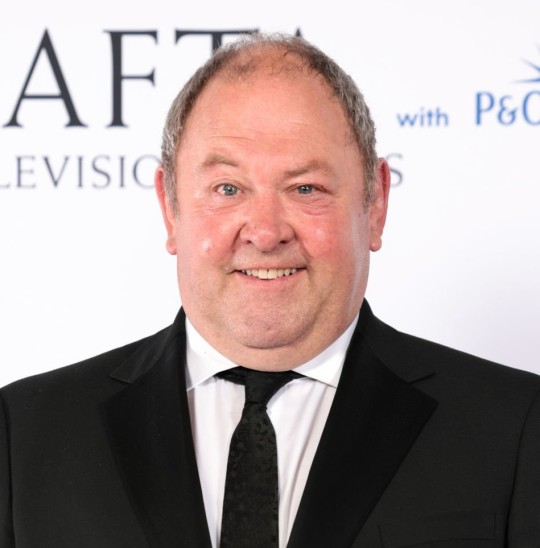
Physique: Husky Build
Height: 5′ 11½″ (1.82 m)
Mark Ian Addy (born 14 January 1964) is an English actor. His roles in British television include Detective Constable Gary Boyle in the sitcom The Thin Blue Line, Andy Richmond in Trollied, and Hercules in the fantasy drama series Atlantis. He made his film debut as Dave Horsefall in The Full Monty, earning a nomination for the BAFTA Award for Best Actor in a Supporting Role. Other notable roles include Fred Flintstone in The Flintstones in Viva Rock Vegas, Bill Miller in the CBS sitcom Still Standing and King Robert Baratheon in the HBO fantasy series Game of Thrones.




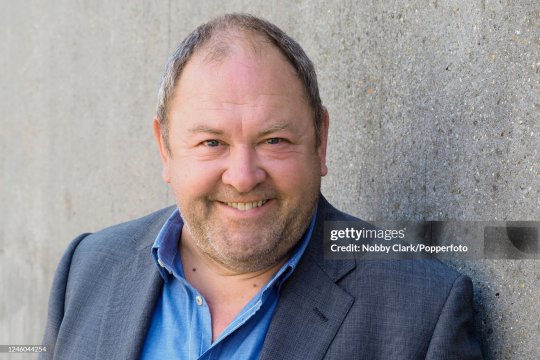
Weird how I noticed him back when I first saw The Full Monty, but he never did anything for me. Now that he’s older, I can fully enjoy lusting after him. I guess he’s one of those guys that gets hotter with age. Can wait to see him 10 years from now.


Unfortunately, like 99.9% of men I find attractive, he appears to be straight. Dammit. He's married and together they have three children. Anyway, he may be straight, but he does look every inch a big fuckable bear.

RECOMMENDATIONS:
Atlantis (2013) - Shirtless
Game of Thrones (2011) - Shirtless
The Full Monty (1997) - Shirtless
62 notes
·
View notes
Text
Case study and analysis of the 1992 Good Omens movie screenplay (“the shitscript”) in light of the ongoing WGA strike
As one could suspect, the topic of the 1992 Good Omens movie screenplay and its infamy has recently emerged from the depths of the fandom. In light of the ongoing WGA strike it’d be good to properly address this issue, starting with Neil Gaiman’s own recollection written in 2004:
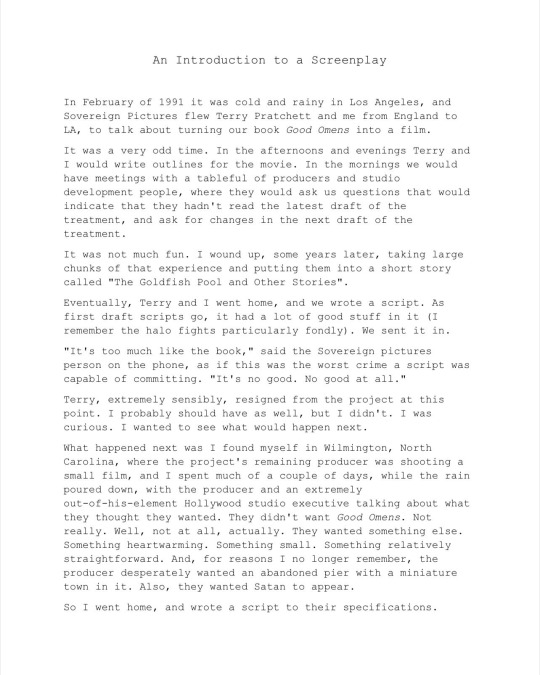

It’s basically the same old story — of brilliant creative workers struggling under the pressure of detached studio executives and being legally forced to mutilate their work again and again for no artistic or economic reason — we’ve heard before in many different contexts.
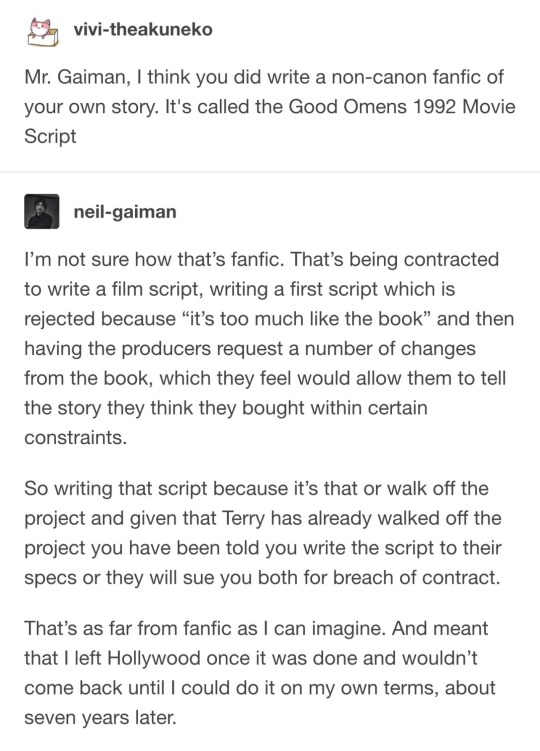
If you’re reading this and somehow still wondering why writers are fighting for their rights at the moment, their job security hasn’t changed much since then. Please follow the WGA, SAG-AFTRA, and other unions’ official channels for detailed information and ways to help the cause.

Anyway, it took over a decade and an enormous effort to print the screenplay in a limited edition of 552 copies. It can’t be distributed otherwise due to IP law, but some fans shared its fragments online and heavily criticized them, dubbing the 1992 source material #shitscript
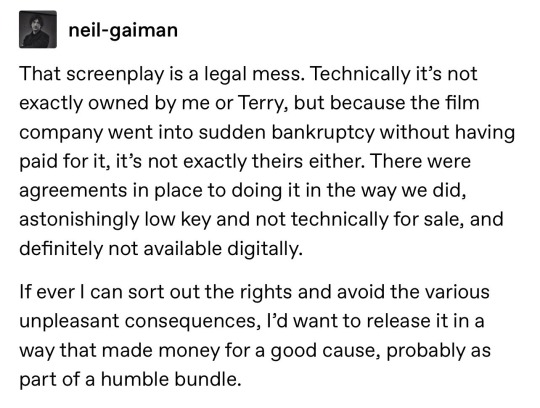
There’s been obviously a lot of controversies over the changes in the plot and the relationship between the main characters. And rightfully so — the number of iterations has created something very different from the beloved book and the award-winning show we can all enjoy today.
It’s… objectively not good. Wouldn’t be considered a hit back then and certainly not by today’s standards. I don’t think I would watch it in any other way than through channel surfing. However, it’s not a monstrosity some people believe it to be and not a case of low effort.
Let’s start with the world building: the setting wasn’t changed to the US. It’s still very much based in the UK, mostly London and Tadfield, although the latter lies now by the sea and seems much more ominous. Interestingly, the British Museum becomes a prominent location as well.
The main character and the designated hero is not surprisingly Crowley, this time in his 90s anti-hero glory. If you haven’t watched many movies of this era, esp. dark fantasy, this trope involves middle-age disenchantment, cynicism, as well as hefty doses of sarcasm and brooding.
90s anti-heroes are a dark, grim, and unnecessarily violent embodiment of power fantasy, matching the destructive ideology of that time. Combined with uber-masculinity and performative strength over weaker characters, nowadays they naturally evoke more cringe or worry than awe.
1992 iteration of Crowley is basically in his Furfur era. Deeply unhappy and stuck in a dead end job, all he talks about is how he hates Earth and his assignment here, considering a transfer to Alpha Centauri as his one and only possibility of career advancement. Or life, really.
The talking part is important here, because he clearly compensates by insulting everything and everyone. He hates on the whole planet at length only to confess that he’d rather stay here with Aziraphale due to “no good restaurants”, “no decent bottle of wine” in Alpha Centauri.
Yes, he’s verbally abusive in his automatic response to stress. But doesn’t hate Aziraphale. In one particular scene he calls Azi stupid twice only to assure him that they are friends and to offer to solve the problem when he sees that his words were taken seriously and hurt him.
Crowley refers to him as “my angel” and “my dear Aziraphale”, agrees to Aziraphale’s suggestion of sharing a room, praises the angel as a “miracle worker around the home”, drinks the tea he makes for him, and generally proves to be much softer towards him than he wants to admit.
Aziraphale, on the contrary, wears his heart on his sleeve. He’s the one engineering ways to spend more time together, following Crowley around, checking up on him (including miracling himself into his apartment and office when no one answers the door), offering help right away.
He’s successfully calming Crowley down through his anxiety attacks, overcomes his dislike of heights (!) for Crowley, directly challenges him and even breaks rules only to make Crowley stay with him. Crowley seems to be his main motivation in this movie, not the saving the world.
1992 Aziraphale also has the most badass scene in the whole Good Omens multiverse to date, taking a 180 degree turn from the typical guardian angel we all know and love to the real angel of wrath protecting Crowley from harm in his true form.
But there’s no Their Side in this universe. The only semblance of that concept appears in the context of Anathema not representing either of their respective bosses, but humanity. “That’s the trouble with the humans. They’re on their own side.”
This Crowley appears not as much on Hell’s side as under Satan’s heel. He’s scared of him and subservient, and needs Aziraphale to prevent his escape as a pretext to do what is right. He lets the angel stop him by pretending that he doesn’t even see him cheating during their duel.
By finally standing up to his toxic boss (Satan is like Gabriel during the body-swapped trial, suave and cruel) and leaving Hell’s side to do good, Crowley takes an emancipated and employee-focused stance instead of fighting for his relationship with Aziraphale like shown in S1.
Which is a shame, but matches the overall tone of the screenplay and the times it was written in. The concept of free will, while simplified in a true Hollywood-style to issues like mind control and fear, is still crucial to this interpretation of the Good Omens original plot.
Especially the character of Anathema is seen fighting both of these things. There’s no Agnes Nutter with her prophecies here, only a 21-year-old witch and her will to thwart the ultimate evil versus her fear of doing it at a cost of one boy’s life, versus Satan’s brainwashing.
Madame Tracy appears slightly redesigned as a new character as well, but isn’t 𝘲𝘶𝘪𝘵𝘦 𝘵𝘩𝘦𝘳𝘦 for the most part. She’s been enjoying her youth way too much to see how fast it was fleeting, and this sudden realization left her in shock from which she denies to come back.
Unfortunately she’s also the one who took in baby Adam and now stays under his care. The level of his parentification is unnerving, much like his bullying and loneliness. He struggles to be loved and ask for love, which becomes his main quest beyond, y’know, the apocalypse thing.
Don’t worry, despite everything all ends well just like in the book. The family of two gets a chance to start again on much healthier terms and Anathema to live for herself for the first time in years. Our heroes get back in their car, Crowley tempting Aziraphale with an apple.
All in all, this whole post is a very long reminder for Amazon Prime to #PayYourWriters, #PayYourActors, and #RenewGoodOmens! The strike is still ongoing and crucial for any new content for this and many other fandoms #GiveMeS3orGiveMeDeath

97 notes
·
View notes
Text
British Fantasy Society Awards Shortlist Announced!
And I’m a Juror for Best Audio Work!
These are the podcasts up for the award:
Breaking the Glass Slipper
The Painkiller Podcast (Bitter Pill Theatre)
Podcastle (Escape Artists)
Pseudopod (Escape Artists)
The Secret of St. Kilda (Michael Ireland & Naomi Clarke)
The Stranger Times (C.K. McDonnell)
For all the shortlists see:
British Fantasy Award Shortlists
View On WordPress
0 notes